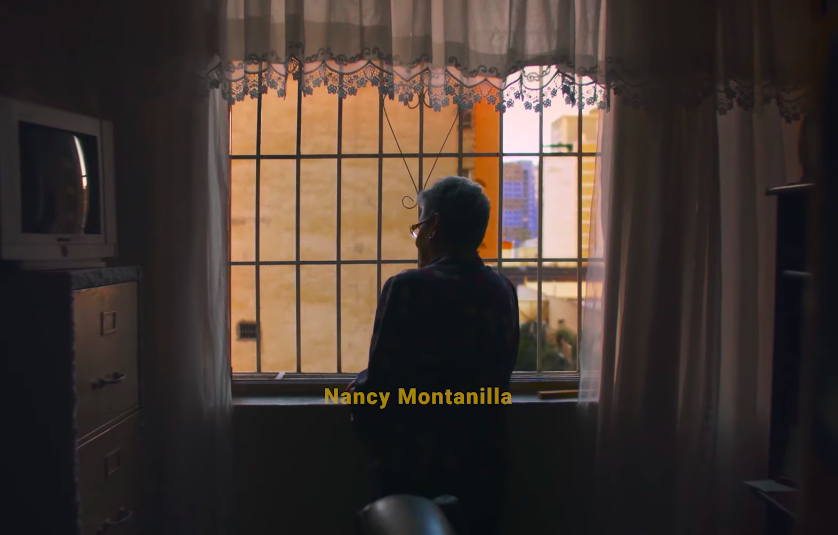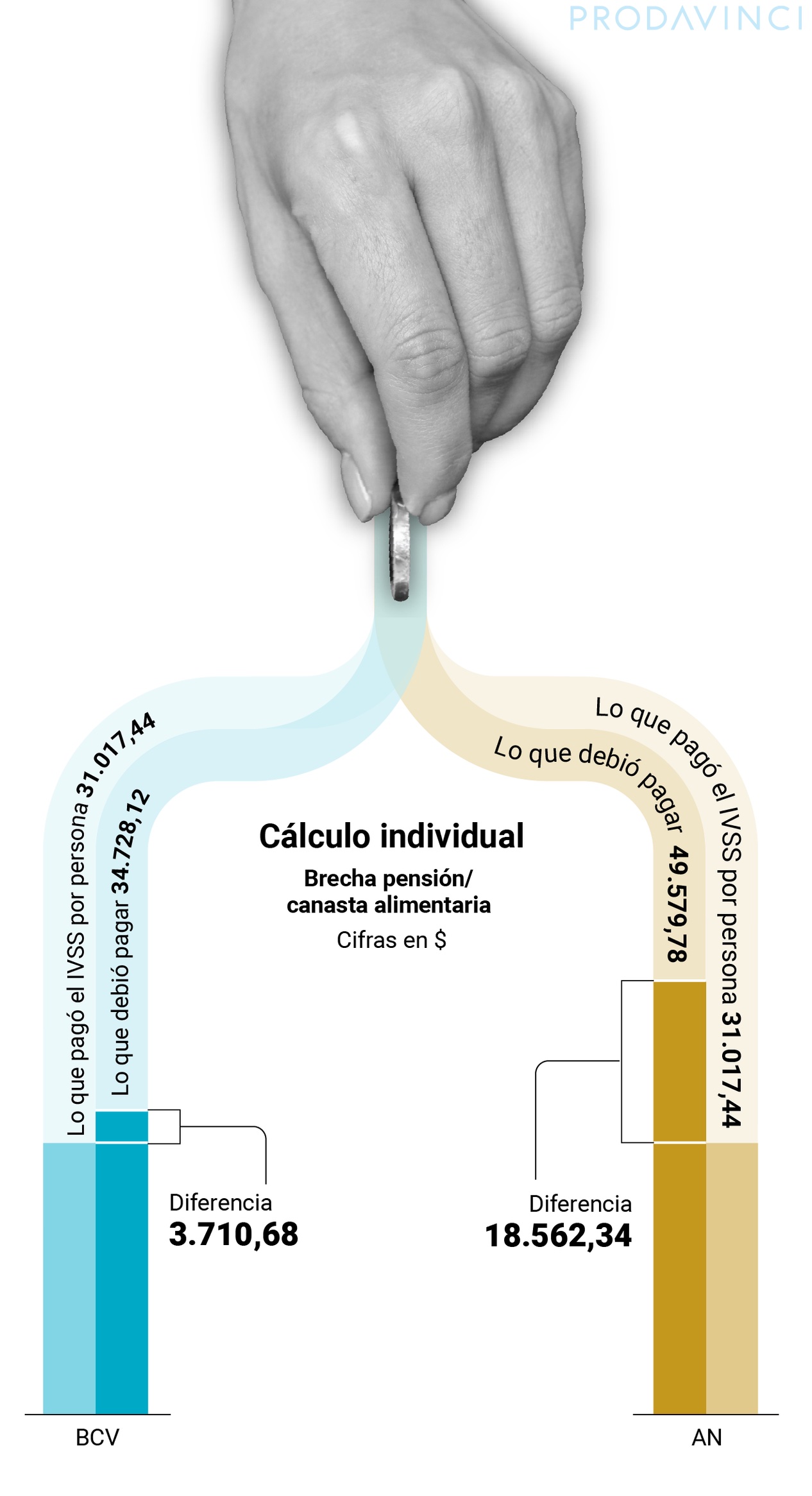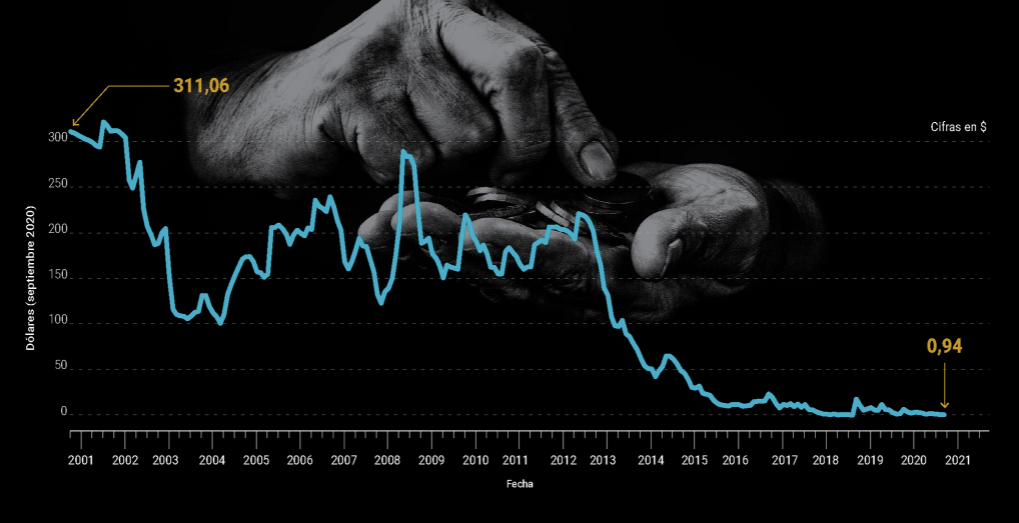Among the multiple casualties of the economic crisis that hit Venezuela in the last two decades, one of the most affected populations was the elderly. In 2019, the digital news outlet Prodavinci took on the task of investigating the reasons why retirees’ pensions did not cover their basic needs.
That year, the news outlet, which since 2009 offers journalistic content and analysis about the Venezuelan current situation, had begun publishing several installments of the feature "Envejecer en Venezuela” (Aging in Venezuela), with stories about how the quality of life for older adults in that country has deteriorated.

The team behind "La promesa rota" was made up of journalists, designers, analysts and photographers, among other professionals. (Photo: King of Spain Award)
“We asked ourselves what was happening to the value of retirement today and we wanted to see if the data could provide a picture of that,” Prodavinci journalist Indira Rojas told LatAm Journalism Review (LJR). “We had already been capturing it through feature stories and reporting about retirees and pensioners. We wanted to see if the data could also tell us the story we were seeing through non-fiction.”
The result was “La promesa rota: el colapso de la seguridad social en Venezuela” (The broken promise: The collapse of Social Security in Venezuela), a multimedia package of data journalism that managed to show that the workers' pension system does not guarantee their subsistence.
Prodavinci analyzed hundreds of salary and pension data from the last twenty years in Venezuela and found, among other things, that Venezuelan workers who retired in 2020 contributed up to 57 times more to Social Security than they will ever receive in pensions in their old age. Also, the pension value in 2000 was up to 330 times higher than it is in 2020.
“La promesa rota,” published on the web in February 2021, received this month the King of Spain 2022 award, in the International Cooperation and Humanitarian Action category. Six months ago, in September 2021, the work obtained a Special Mention in the Investigative Journalism category at the Instituto Prensa y Sociedad Venezuela (IPyS, by its Spanish acronym) awards. It was also among the finalists of the Online Journalism Awards 2021, in the category of Investigative Data Journalism.
The feature package managed to overcome current political polarization and lack of transparency in Venezuela by creating databases that did not previously exist in the country, while forging a personal and emotional bond with readers through the combination of data journalism, text, audiovisual and artistic elements.
The team behind "La promesa rota" found that in Venezuela there were not enough official databases on state workers’ salaries for the past 20 years. So they decided to turn to different trades and trade unions from various public sector areas, such as the police, military, doctors, and nurses to do their research.
The only data they were able to find was from education personnel: elementary education teachers and university professors.

The documentary short film "Nunca hubo después" is part of the report. (Photo: Screenshot)
"There is not a single industry that has complete data compilation. That was one of the largest efforts we undertook with this work," Salvador Benasayag, Prodavinci journalist in charge of the feature, told LJR. "We could not even attempt to do a reconstruction of other industries."
Teachers turned out to be a representative sample of the universe of public sector workers in Venezuela. Education is one of the largest employers in the country. Until 2015, there were more than 2.5 million public employees in the country, according to the organization Espacio Público. Of these, about 700 thousand are teachers.
"In the case of teachers and professors, it turned out we had the most complete data possible, the most up-to-date. They really belong to the broadest and most representative groups," Benasayag said. "Teachers are always a reference point on how the issue of public compensation works."
The King of Spain Award jury highlighted the way in which Prodavinci overcame the difficulties in collecting information and building their own databases, which took nearly three months.
“There is no organized source for these industries through which to consult the data. It would be really ideal for these industries to have a more detailed record over time [of the data] of what they earn, especially since this is also of interest to the workers,” Benasayag said. "That does not exist here. It was very complicated and it took us a long time."
The opacity forced the team to gather pieces of information from different sources and collected under different methodologies and scales. Despite this, they managed to put together a coherent database that allowed them to reach their findings.
“In Venezuela, journalists cannot make a request, like in other countries, that have an access to public information law,” Benasayag said. "It always turns out that someone obtains the data, but it is always through a leak or a trusted source. But there is no legal procedure, no government public data page where everything is centralized.”
But the challenges were not limited to a lack of transparency. To design the analysis methodology that would allow them to calculate the drop in the pensions’ value, the team's analysts had to consider macroeconomic factors such as inflation, the exchange rate and the minimum wage, data that are not as accessible or present a certain level of bias, depending on the source that issues them.
Political polarization in Venezuela has influenced the reliability of public data that is published. For example, the Central Bank of Venezuela (BCV) —the body responsible for publishing the country's macroeconomic data– stopped publishing this information between 2015 and 2019. In 2016, President Nicolás Maduro managed to gain control of this body.
In response, the National Assembly (AN), which in 2016 had an opposition majority, began compiling macroeconomic data and building parallel databases. Organizations such as the International Monetary Fund, the Inter-American Development Bank and private consultants began to take these data as the only available indicators. The Prodavinci team decided to do the same for its methodological consideration.
“There was conflicting data and a decision had to be made. At that moment we decided, from the journalistic point of view, that the best way to establish certain calculations was to use both sets of data,” Rojas said.
The team chose to provide the reader both perspectives. For example, the graphs that show the impact of inflation on workers' pensions in the last 20 years were made taking into account both the BCV and AN inflation figures, so the reader could make a comparison.

The graphics in the report contrast data from the different sources. (Photo: Screenshot of "La promesa rota")
The team also faced the dilemma of deciding in which currency to reflect the calculations of its analysis. Although the bolívar remains the official currency of Venezuela, in the last decade the US dollar has become the unofficial currency in the country, due to factors such as the devaluation of the bolívar and the hyperinflation of the economy.
“We calculated the value of pensions in US dollars based on the minimum wage and its conversion with the exchange rate between bolivars and dollars, in order to make an equivalence that could also be understandable and useful, not only for Venezuelans but for readers of other countries,” Rojas said.
Although the core of “La promesa rota” is its data collection and analysis methodology, the organizations that have recognized this work with awards also spoke of innovation in the way the findings were presented.
The feature story consists of a multimedia explainer that combines data analysis with visualizations. It explains in detail and in an accesible way, the complexity of the social security collapse in Venezuela.
“Given that the information is a bit dense, we wanted it to be as clear as possible. The explainer gives us the opportunity to make a data and numbers topic much more digestible for the reader,” Rojas said. “Since, in this case ,we also wanted to prioritize charts and tables, the explainer allows you to use very little text and give priority to the visuals. We wanted to take advantage of that.”
“La promesa rota” also includes six stories that highlight the project's findings through real stories of Venezuelan retirees. In addition, it incorporates a photographic work entitled "Los Olvidados," (The forgotten ones) by photographer Carlos Becerra, which shows what life is like inside retirement homes for the elderly in that country.
The work also includes artistic elements: two collage collections, “Balance del ejercicio anterior” (Balance of the previous exercise)” and “Promesa rota” (Broken promise), by the artists María Elena Álvarez Lourens and Josefina Núñez, respectively, who seek to render the journalistic content in artistic form. In addition, the documentary short film "Nunca hubo después” (There was never an after), directed by Edwin Corona Ramos and produced by director of innovation at Prodavinci Helena Carpio, shows testimonials of people who depend on the Venezuelan social security system.
The goal of including these elements was for the reader to forge a personal and emotional bond with the feature story, beyond the dryness of numbers.
“The human side is always necessary. I was very concerned that this explainer would prioritize data visualization and not create a connection with the reader. It turned out to be quite the opposite and it actually came up as a surprise: a lot of people could relate, I believe, precisely because of what the numbers conveyed about their own situation.
Through “La promesa rota,” Prodavinci seeks to contribute to the debate on pension systems at a more global scale, through journalism on a problem in Venezuela that is replicated in other countries in the region.
“It’s an issue that is obviously not restricted to our country,” Benasayag said. “It’s something that is current and that is part of a great debate in Latin America, about what are the ideal pension systems. Should they change or not, when people cannot meet their needs… In the end, this adds up to the public policies debate.”
Prodavinci is known for establishing close collaborations with specialists in topics it deals with in their feature stories. For the special “Incendios en Venezuela” (Fires in Venezuela), which also came out in 2021, the digital news outlet teamed up with scientists and academics to analyze data from open sources on forest fires in protected natural areas in Venezuela. The work was nominated for the Gabo Award in the Innovation category last year.
"This joint effort with specialists is a strength of Prodavinci," Rojas said. “We must also assume that as reporters, we may not have all the knowledge and tools to make the most precise calculations.”
“It was very important to have the consensus of several people who understood that the methodology was not only the best for readers to understand, but it was also the most appropriate from the point of view of the underpinning social science, in this case economics,” Benasayag said.
Rojas emphasized that "La promesa rota" includes the calculation of projections, something that, he said, is not usual in data journalism projects. They achieved this thanks to the input of specialists in economics and financial mathematics.
Prodavinci collaborated with the independent consulting firm ANOVA Policy Research to calculate a projection on income poverty. They wanted to find out how many people would have been lifted out of poverty if a pension similar to the value of a basic food basket had been paid. This was possible thanks to poverty calculations available to ANOVA.
The rest of the financial calculations on salaries and pensions as well as the adjustments for inflation were prepared by the Prodavinci team, with the support of specialists.

The project explains in detail the complexity of the collapse of social security in Venezuela. (Photo: Screenshot of "La promesa rota")
"There are calculations, data and information that need a lot of eyes to get it right," Rojas said. “We can be great data journalists, but I believe that if we can always count on the support of experts, we have added value in our work. We are always thinking of readers, so they receive quality work, which has been reviewed, which has already passed through the hands of specialists who vetted it.”
After the amount of work "La promesa rota" took, its producers agree their main satisfaction is readers’ reaction to the features' findings.
Rojas and Benasayag said that, after its publication, people shared similar stories to those of the testimonials. They were about people who had worked all their lives in hopes of getting a good pension, but then got meager pensions not enough to get by.
"We’ve had a lot of feedback from people in academia, even also from politicians, from many industries, and also from a general readership, who share personal anecdotes about their family, their parents or themselves, who share the drama behind these numbers,” Benasayag said.